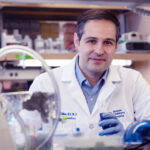‘Heart on a chip’ suggests a surprising treatment for a rare genetic disease

It was the variability that intrigued pediatric cardiologist William Pu, MD, about his patient with heart failure. The boy suffered from a rare genetic mitochondrial disorder called Barth syndrome. While he ultimately needed a heart transplant, his heart function seemed to vary day-to-day, consistent with reports in the medical literature.
“Often patients present in infancy with severe heart failure, then in childhood it gets much better, and in the teen years, much worse,” says Pu, of the Cardiology Research Center at Boston Children’s Hospital. “This reversibility suggests that this is a disease we should really be able to fix.”
Though it needs much more testing, a potential fix may now be in sight for Barth syndrome, which has no specific treatment and also causes skeletal muscle weakness and low white-blood-cell counts. It’s taken the work of multiple labs collaborating across institutional lines.
In Stockholm for a stem cell symposium a couple of years ago, Pu saw a presentation by Kevin Kit Parker, PhD, of the Wyss Institute for Biologically Inspired Engineering and the Harvard School of Engineering and Applied Sciences (SEAS). Parker was building hearts on a chip using cells from rats, and stretching the tissue to model failing heart muscle, with the goal of testing potential treatments for heart disease:
“I approached him and said, ‘There’s a disease that we see at Boston Children’s—we have to put these things together,’” recounts Pu. “We got excited, and things happened fairly quickly.”
Pu and Parker joined forces, along with other researchers at Boston Children’s, the Wyss Institute, the Harvard Stem Cell Institute, SEAS and Harvard Medical School to create a “heart on a chip” specifically modeling Barth syndrome.
The Barth Syndrome Foundation soon became a partner too.

“It was an amazing opportunity to test potential treatments that might help people with Barth syndrome around the world—in actual cells with the disorder,” says Kate McCurdy, a founding board member of the foundation, whose son William, 28, is one of the oldest people living with Barth syndrome. (William, too, has followed the pattern that intrigues Pu: heart failure at age 2, then relative good health on heart medications up until high school, followed by a severe decline.)
The foundation provided seed funding and helped Pu get skin samples from two patients with Barth syndrome. As recounted in this press release, the research team transformed the skin cells into induced pluripotent stem cells, capable of creating virtually any tissue type—in this case, heart cells. The heart cells were then grown on chips, building diseased tissue that contracted very weakly, much like the patients’ own heart muscle:
Further testing in the model brought the team to a new understanding of Barth syndrome. “Barth syndrome cells produce an excess amount of reactive oxygen species, or ROS, which had not been recognized as an important part of this disease,” says Pu. “We showed that, at least in the laboratory, if you quench the excessive ROS production you can restore contractile function.”
It’s early days, but if ROS is the target, antioxidants could be a potential treatment. “First we have to establish in animals or in patients that this mechanism really holds,” cautions Pu. “Then the challenge is how to get enough antioxidant to the right place to quench the excessive ROS production. We think it has to go right into the mitochondria.”
Although fewer than 200 people are known to be living with Barth syndrome worldwide, the work—collaborating across multiple fields of biology and engineering—elevates organ-on-a-chip technology to a new level and sets a powerful precedent in medical research.
“It’s a really good example of where trying a new technique in a rare disease actually has much broader scientific ramifications,” says McCurdy. “Donating biological specimens is a great way for laymen to help advance science, and collaboration in the right circumstances can accelerate things exponentially.”
Related Posts :
-

Four things you should know about MAPCAs treatment
As the first grandchild in her family, Hannah Homan is in demand for frequent visits. She was also the focus ...
-

A case for Kennedy — and for rapid genomic testing in every NICU
Kennedy was born in August 2025 after what her parents, John and Diana, describe as an uneventful pregnancy. Soon after delivery, ...
-

Treating MAPCAs with unifocalization surgery and cardiology care
Children born with a rare form of tetralogy of Fallot (ToF) face a challenging type of congenital heart ...
-

The journey to a treatment for hereditary spastic paraplegia
In 2016, Darius Ebrahimi-Fakhari, MD, PhD, then a neurology fellow at Boston Children’s Hospital, met two little girls with spasticity ...





